Properties of Enzymes
Important Questions on Properties of Enzymes
Students investigated a sample of amylase from Goats. Small filter paper discs were each soaked in a different sample of goat amylase. The students tested the activity of these amylase samples using plain paper. The plain paper contains starch. A circle of plain paper was placed into a petri dish as shown in the diagram below. Iodine solution was used to stain the starch on plain paper.
Ten amylase-soaked filter paper discs were placed into one of the Petri-dishes as shown in the diagram. The students lifted the filter paper discs at one-minute intervals and recorded the number of areas where there had been a reaction.
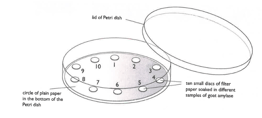
If a reaction had not taken place, the students replaced the disc of filter paper for another minute. This procedure was repeated for five minutes. Their results are recorded in the table below.
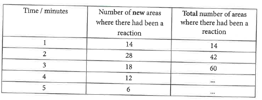
Suggest three ways in which you could improve this investigation.
Students investigated a sample of amylase from Goats. Small filter paper discs were soaked in a different sample of goat amylase. The students tested the activity of these amylase samples using plain paper. The plain paper contains starch. A circle of plain paper was placed into a petri dish as shown in the diagram below. Iodine solution was used to stain the starch on plain paper.
Ten amylase-soaked filter paper discs were placed into one of the Petri-dishes as shown in the diagram. The students lifted the filter paper discs at one-minute intervals and recorded the number of areas where there had been a reaction.
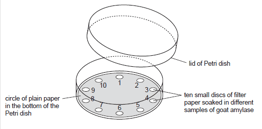
If a reaction had not taken place, the students replaced the disc of filter paper for another minute. This procedure was repeated for five minutes. Their results are recorded in the table below.
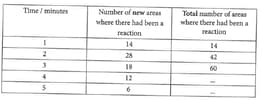
Suggest two reasons for the differences in amylase activity of the samples.
Students investigated a sample of amylase from Goats. Small filter paper discs were each soaked in a different sample of goat amylase. The students tested the activity of these amylase samples using plain paper. The plain paper contains starch. A circle of plain paper was placed into a petri dish as shown in the diagram below. Iodine solution was used to stain the starch on plain paper.
Ten amylase-soaked filter paper discs were placed into one of the Petri-dishes as shown in the diagram. The students lifted the filter paper discs at one-minute intervals and recorded the number of areas where there had been a reaction.
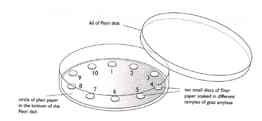
If a reaction had not taken place, the students replaced the disc of filter paper for another minute. This procedure was repeated for five minutes. Their results are recorded in the table below.
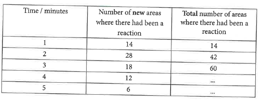
Plot a graph using the data from the first two columns, to show the differences in the activity of amylase.
Students investigated a sample of amylase from Goats. Small filter paper discs were each soaked in a different sample of goat amylase. The students tested the activity of these amylase samples using plain paper. The plain paper contains starch. A circle of plain paper was placed into a petri dish as shown in the diagram below. Iodine solution was used to stain the starch on plain paper.
Ten amylase-soaked filter paper discs were placed into one of the Petri-dishes as shown in the diagram. The students lifted the filter paper discs at one-minute intervals and recorded the number of areas where there had been a reaction.

If a reaction had not taken place, the students replaced the disc of filter paper for another minute. This procedure was repeated for five minutes. Their results are recorded in the table below.
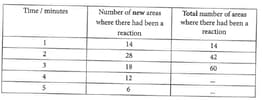
Copy and complete the table by calculating the total number of areas where there had been a reaction after 4 and 5 minutes.
Three enzymes P, Q, R were extracted from a different region of the alimentary canal of a mammal. The effect of On the activity of the enzymes was investigated at C. The results are shown in the diagram below. Using the information in the diagram, describes the effect of increasing On the rate of activity of enzyme Q?
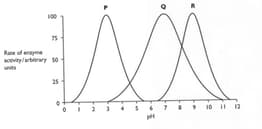
Three enzymes P, Q, R were extracted from a different region of the alimentary canal of a mammal. The effect Of On the activity of the enzymes was investigated at C. The results are shown in the diagram below.
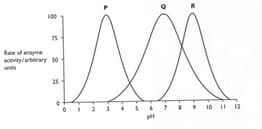
Explain Why the investigation was carried out at C.?
Explain why the rate of reaction slows down above the enzyme’s optimum temperature?
Explain why the rate of enzyme-controlled reaction is relatively slow at low temperatures.
A protease enzyme is found in the stomachs of humans. The stomach contains Hydrochloric acids. Suggest the optimum For the activity of this protease enzyme.
A protease enzyme is found in the stomachs of humans. It catalyzes the breakdown of long chains of amino acids (proteins) into individual amino acid molecules. Suggest the optimum temperature for the activity of these protease enzymes.
Explain the meaning of this term: Denatured
Why are the enzymes damage by high temperature?
What is the optimum temperature for the enzyme in given figure?
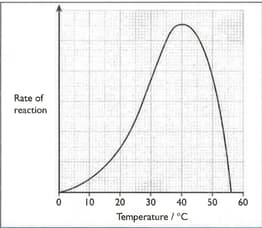
What is meant by an optimum temperature?

